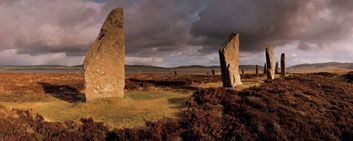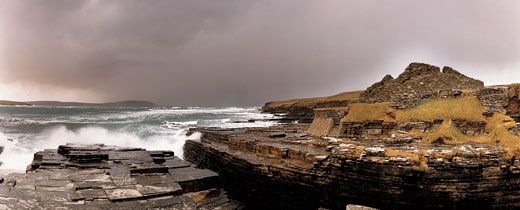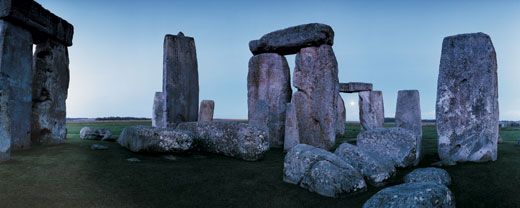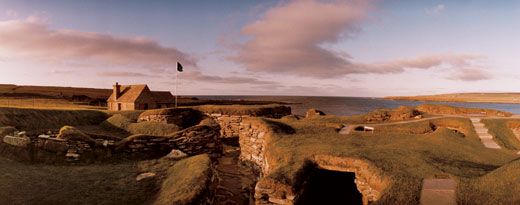Romancing the Stones
Who built the great megaliths and stone circles of Great Britain, and why? Researchers continue to puzzle and marvel over these age-old questions
/https://tf-cmsv2-smithsonianmag-media.s3.amazonaws.com/filer/stones_main_388.jpg)
Steady rain fell diagonally, driven by a raw wind out of the north, and I narrowed the hood of my parka. With neither tent nor bag, I faced an unpleasant night on southern England's Salisbury Plain. At least my vigil would not be solitary. Around me a boisterous crowd of some 7,000 was camped on the turf at Stonehenge, the enigmatic circle of towering sandstone slabs capped with heavy lintels, whose origins lie in the Neolithic age, some 5,000 years ago. "The most celebrated prehistoric monument in the world," the distinguished archaeologist Sir Colin Renfrew called Stonehenge.
In 2000, fifteen years after the British government closed it to large groups of revelers—following desecration of the site and the death by drug overdose of a young woman in 1984—Stonehenge was reopened to groups, and a long tradition of celebrating the summer solstice resumed. Now, as I huddled in my foulweather gear, I observed an odd assortment— neo-hippies, self-styled latter-day Druids in white cloaks, Goths in black, New Agers of all persuasions, tattooed bikers, drunken "brew crew" louts of the sort that have given English football a bad name, along with suburban-looking families with young kids, and elderly couples. For hours, people played drums, zithers, horns and didgeridoos; hugged the stones, eyes shut in beatific trance; kissed each other as they stood inside the trilithons (as the assemblies of uprights and lintels are called); and danced upon the recumbent boulders. There were drugs, drink and a little nudity, but came a bleak, misty dawn and not one person had been arrested. The celebrants had even picked up their trash.
No matter how much mumbo jumbo gets projected onto Stonehenge, the intensity of the feelings of my fellow campers testifies to the enduring power the austere stone ring exerts upon human souls. Currently, a million visitors a year walk the designated path just outside the stone circle, marveling at the trilithons. Despite a century of serious archaeology, we still have only the foggiest ideas about why and how Stonehenge was built.
From Caesar's invasion of the British Isles in 54 b.c., which brought literacy to the country, until the 1130s a.d., Stonehenge went strangely unmentioned in the written record. Yet when Geoffrey of Monmouth set down his pioneering History of the Kings of Britain around 1136, he purported to know exactly how the stone circle had come into being. It first had stood "in the remotest confines of Africa," he wrote, "until a race of whimsical Giants transplanted it to MountKillaraus in Ireland." Then, in a.d. 480, the stones were moved to England.
Over the centuries since, British commentators have attributed the monument variously to Romans, Danes, Phoenicians, Druids, or the denizens of Atlantis—just about everyone but the native Brits themselves. As late as 1960, Richard Atkinson, then the leading expert on Stonehenge, argued passionately that a Mycenaean or Minoan architect must have directed native builders. And in 1966, Gerald Hawkins argued in Stonehenge Decoded that the megaliths made up a sophisticated observatory in which the stones served to record solstices and equinoxes and even to predict lunar eclipses. The book was hugely popular, but Hawkins' conclusions have been largely debunked.
Exactly how people with neither metal nor the wheel were capable of quarrying, dressing, transporting and erecting huge stones has been the subject of intense debate for centuries— though an experimental archaeology project in 1994 proved that, with a deft use of sledges, rails, ropes, ramps, pivot blocks and "tilting stones," as few as 100 people would have been needed to move and raise the 40-ton Stonehenge uprights.
For all its inscrutable majesty, it would be a mistake to view Stonehenge as one of a kind—an anomalous temple incomprehensibly erected on a treeless heath in the middle of nowhere. All over Western Europe, Neolithic (roughly 4000 to 2000 b.c.) builders constructed startlingly sophisticated monuments: not only stone circles but huge earthworks containing chambered tombs for the dead. Across Britain alone, there are some tens of thousands of ancient sites, each of which has it own unique stamp, its own idiosyncratic mysteries.
Twenty miles north of Stonehenge stands a monument every bit as enigmatic as its more famous rival, and because of its size, possibly more important. Avebury, which dates from about 2600 to 2400 b.c., does not strike the eye at first glance, as Stonehenge does. A town that first sprang up around a.d. 600 sprawls on top of it, and a paved road cuts through it.
Yet Avebury's grandeur slowly unveils itself. More than a thousand feet in diameter and composed of some hundred stones, it is the largest prehistoric stone circle in the world. Those stones that remain standing today are not dressed and squared like the pillars of Stonehenge. Instead, they reflect all the erratic, lumpy glory of nature's fashioning. Avebury's most astonishing feature, however, is a circular ditch that surrounds the stones, fully 25 feet deep and 60 feet wide. Archaeologists suspect that the principal tool used to dig the huge ditch was the red deer antler.
"[I]t does as much exceed in greatness the so reknowned Stonehenge, as a cathedral doeth a parish Church," wrote John Aubrey, the 17th-century antiquarian best known for his gossipy Brief Lives. Avebury has never been properly excavated. Its chief 20th-century investigator, an amateur archaeologist named Alexander Keiller (grown rich from the marmalade that bears the family name), "restored" it in the 1920s to the puzzling state in which it languishes today. He set a concrete plinth in the ground wherever he had reason to believe a vanished stone once stood.
Were Avebury and Stonehenge temples of some kind? Did the ring of stones and the banked ditch define a sacred interior space or a place of initiation? Or did they create a space to exclude the nonbelievers? Were "henges"—the term has come to mean a circular earthwork with a ditch inside— buildings, or did they loom instead as roofless pillared assemblages? Another question is why the Salisbury Plain was such an important place. The questions await answers.
Beyond Avebury and Stonehenge the region abounds in prehistoric monuments. In WiltshireCounty alone there are 2,300 barrows—linear tombs covered with earthen mounds. West Kennett long barrow lies a mile from the Avebury ring. Archaeologists dug into it as early as 1859, and again in the 1950s. What they unearthed was an exquisitely constructed tomb in the shape of a long passage giving onto small side chambers. Great sarsen stones planted upright defined the grave space, with equally heavy stones set in place as roofing. Within the chambers lay not just simple skeletons but curious, sorted assemblages of human bones.
An even more remarkable monument near Avebury is Silbury Hill, at 130 feet high the largest man-made mound in Europe and long assumed to hide treasure. So far, excavations into the hill have failed to find a single human bone, much less any treasure. Instead, the diggers' shafts and tunnels have revealed a complex set of nested, reinforced walls of chalk rubble and boulders. Is Silbury Hill a tombless pyramid, meant to elevate worshipers toward a godhead in the sky? Whatever its purpose, there is no ignoring the labor its construction required: by one estimate, four million man-hours, or the toil of 300 to 400 men over five years— far more than it took to build Stonehenge and Avebury combined.
From Wiltshire I headed to the single most striking arrays of Neolithic monuments in Britain, in the remote, sandstone-rich Orkney Islands off the Scottish coast. On a narrow isthmus of land between two sizable lakes, smack in the center of the main island, called Mainland, lurk the remains of two great stone circles, the rings of Brodgar and Stenness. However ruined they may be (only four of Stenness' monoliths—large single stones—still stand), I found these two monuments the most haunting of all—thanks in part to their setting, in a sheltered bowl in the heart of the wind lashed archipelago surrounded by rippling lakes, and in part to the soaring thinness of the tallest stones. Neither ring has been fully excavated, but both antedate the stones of Stonehenge.
Half a mile east of Stenness, a smooth grassy mound rises up from the level pasture around it. Weeds and buttercups cover Maes Howe, the finest chambered tomb in Britain. I crawled on hands and knees 30 feet through the gently inclined tunnel, lined with massive slabs exquisitely dressed and fitted, that leads to the tomb itself. Then I stood up in an inner sanctum roomy enough, at 15 feet square by 15 feet high, to house a small town meeting. The walls are built of indigenous flagstone, masoned by a master hand. It was through the roof in a.d. 1153, according to legend, that a band of Vikings seeking refuge in a bad storm broke in to Maes Howe. As they idled in the dank chamber, the Norsemen carved on the walls. These well-preserved graffiti amount to the single largest collection of Norse runes ever found.
Magnificent though it is, Maes Howe is far from unique. In fact, 86 chambered tombs, mostly unexcavated, have been identified at Orkney. From those that have been excavated, a puzzling scenario emerges: picture a tableau in which shortly after death a body is deliberately defleshed—either by exposure to predators (as in Tibetan sky burial) or perhaps by priests using knives to carve the flesh from the bones. The skeleton is then disarticulated—broken into its separate bones. These are mingled with the bones of other dead, sorted according to some lost formula, and laid in arcane arrangements inside a chambered tomb, where priests might have performed ritual ceremonies. On the ground within a side chamber of the tomb of Knowe of Yarso on the Isle of Rousay, the first diggers found 17 skulls, their mandibles removed, arranged to face the chamber's center.
I asked David Miles, chief archaeologist of English Heritage, the government agency charged with protecting England's archaeological sites, what purpose such a procedure might have served. "Ancestor worship," he speculated. "The single individual was not so important. The idea of a collective ancestry was. The dead are excarnated—perhaps flesh itself was regarded as dangerous or evil. Then carefully selected collections of bones are used in ceremonies."
Orkney also boasts the single-bestpreserved Neolithic village ever found in Britain, Skara Brae, which was first uncovered by a violent storm in 1850. Today the visitor can wander pathways without invading the "houses" themselves, which lie open to the sky. The most surprising aspect of these domiciles is that even the furniture stands in place—stone dressers, hearths, bed platforms, and stools, all arranged in a uniform pattern within each house. At first the houses feel cozy. Then I noticed crawlways between them, a secret chamber in House 1 that could be reached only by crawling under a dresser, bar holes beside doorways to lock houses against intruders and peepholes to spy on outsiders. A tension of distrust seems built into Skara Brae's very architecture. What's more, as experts point out, the houses of the Neolithic denizens strikingly mirror their tombs.
At the same time that archaeologists remain baffled by some of the most basic questions about Neolithic culture— from the language its people spoke to the engine that drove the economy— they have wrung a surprisingly rich understanding of daily life from the tombs of Orkney. We know that the adults of that period were not much shorter than today, men averaging 5 feet 7 inches, women 5 feet 3 1/2 inches. They were muscular but prone to broken bones; their teeth were surprisingly free of decay but ground down from grit in their food. The life expectancy was about 35 years. Perhaps one in three babies died in childbirth.
Was Neolithic life, then, nasty, brutish and short? In many ways, certainly; but the scarcity of fortifications and weapons found in the archaeological record suggests that the epoch was relatively peaceful. It's even possible that the act of building massive monuments to ancestors was the glue that held society together.
Four years ago, in Norfolk, the county that juts like a fat paw into the North Sea 120 miles northeast of London, a local beachcomber, John Lorimer, stumbled upon one of the great prehistoric finds of the century— and touched off a furor. Walking the beach near Hunstanton, Lorimer noticed a huge, upside-down tree trunk sprouting from the sand, halfway between the high- and low-tide mark. Then, 25 feet from the stump, he picked up a metal object. A self-taught antiquarian, Lorimer guessed he had found a Bronze Age ax head. An archaeologist proved him right, dating it to 1600-1400 b.c. A few months later, Lorimer noticed that the upside-down tree trunk had company: three posts sticking several inches out of the sand. On subsequent visits, he found more posts, and soon recognized that they were laid out in a circle, with the tree trunk at the hub.
Lorimer had discovered what the press soon dubbed Seahenge. The first archaeologists to visit the site, scholars from the Norfolk Archaeological and Environment Division in Norwich, knew at once that the post circle was ancient and important. But precisely what it was perplexed them. As early as 1925, evidence of henges made of wood—entirely vanished today—was discovered from the air by patterns of posthole rings in the ground. (Stonehenge itself, experts later concluded, had been made of timber a thousand years before the stone trilithons were raised.) Never before, however, had any original timbers been found. Seahenge was that rarest of things—an apparent wooden henge with wood intact, miraculously preserved by the deep bed of peat that lay above it. A dendrochronologist cut a wedge out of the central inverted oak and, using the most advanced radiocarbon dating techniques, came up with a date that is stunningly accurate—the central oak and posts were felled in 2049 b.c.
Evaluating the site in 1998, the Norwich team determined that Seahenge was in immediate danger due to the erosion of the protective peat. Though the policy of English Heritage is to leave artifacts where they are found, the urgency of the perceived threat led to a decision to remove the timbers. But as archaeologists prepared to do so in May 1999, all hell broke loose. Some of the same New Agers and neo-Druids who would celebrate the solstice with me at Stonehenge flocked to the Seahenge beach, determined to block the excavation. They were joined by locals who also felt that the timbers should be left in place. "There was lots of verbal abuse," Maisie Taylor, a specialist in waterlogged archaeological sites, recalls. "The young archaeologists took the worst of it. We had hate mail and even death threats. Eventually we had to have police protection." Ultimately, the excavation went forward. Slowly, as each high tide brought with it muck and sand, the team, led by archaeologist Mark Brennand, made some intriguing discoveries. Bronze Age axmen (or women) had cut notches into the trunk of the giant oak stump, most likely to keep it from slipping when maneuvering it with a rope. Indeed, rope fragments, unbelievably still in place, proved to be braided of honeysuckle; nothing like them had ever before been found. As for the ellipse of timbers, from 15 to 18 feet across, it turned out not to be a henge at all. There was no trace of a surrounding ditch, and the timbers stood tight to one another like a palisade, with no apparent doorway. (Brennand thinks a single forked post may have served as the entryway; initiates would have had to clamber through the forked V to get inside.) Finally, in August 1999, the last post was taken out of the sand. Each timber was carried by military stretcher to a trailer and driven to Flag Fen laboratory in Peterborough, where all 55 of them were submerged in preservation tanks filled with constantly moving water.
Archaeologist Maisie Taylor gave me a tour of the Flag Fen facility, which is open to the public. Delicately, she lifted one six-foot log out of the water and held it for my perusal. I was instantly struck by the ax marks that had trimmed it—the first evidence of tool use ever found in Britain. "What little Bronze Age woodworking we've ever seen demonstrates an amazing sophistication," Taylor said. Using state-of-theart laser-scanning techniques, experts identified the "fingerprints" of some 38 different axes that, remarkably, had been used to hew the timbers of Seahenge.
Taylor invited me to touch the log. It felt like a cooked mushroom. "You could take it out with your fingernail," she said, putting it back in the water. Once the timbers have been studied, they will be sprayed with fixative chemicals.
In the meantime, the Seahenge discovery underscores the notion that for all the permanence of stone monuments, equally magnificent monuments crafted out of wood once spread from one end of Britain to the other: wooden tombs, timber circles, standing timbers carved with intricate designs—all vanished but for their vacant postholes.
Almost a year after Taylor and her group excavated Seahenge, I drove up the Norfolk coast to talk to local villagers about the excavation. "I played on that beach when I was 8 or 9; I'm 68 now," retired builder and fisherman Geoffrey Needham told me between sips of lager at the Whitehorse Pub in Holme-nextthe- Sea. "As long as I can remember, that big oak stump has been sticking out. They should have left it. The shifting sands would have covered it up. It would come and go as always." Needham showed me a postcard of Seahenge made from a photograph taken by his sister Wendy George that he said many of the protesters still carry with them like a talisman. Back in London, I told English Heritage's David Miles about my conversation in the pub. Miles said he thought it unlikely that Needham could have seen the oak stump as a child; the timbers were exposed only a few years ago. (In all likelihood Seahenge had been built some distance inland. Four thousand years of eroding, crashing waves had brought the seashore to the monument.)
"I see it as a sacred space," Miles went on. "There are anthropological parallels in which an upside-down tree serves as a channel into the underworld and the heavens. Trees blasted by lightning were said to be ‘chosen by the gods.' " Miles looked at the postcard, then smiled a rueful smile common to archaeologists confronted by mysteries about the past. "But of course we really don't know.



